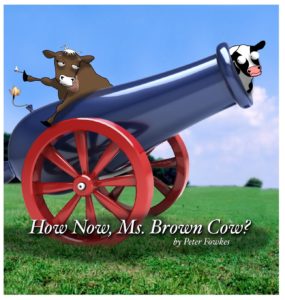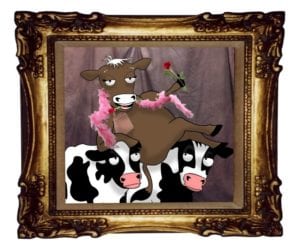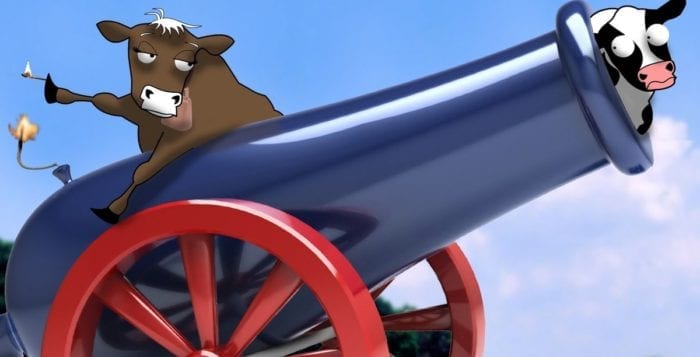Reviewed by Rita J. Egan
When three cows embark on an adventure to the beach, things can get a bit tricky, but that doesn’t stop Ms. Brown Cow. Children will discover that when one is determined to achieve a goal, even when obstacles are present, one can accomplish almost anything in the delightful children’s book “How Now, Ms. Brown Cow?”

Written and illustrated by Port Jefferson native and St. Anthony’s High School graduate Peter Fowkes, the self-published book features witty yet simple rhymes and vibrantly colored funny illustrations. The story is one that will surely provide little ones with plenty of giggles as Ms. Brown Cow finds a solution to any problem.
In addition to the “How Now, Ms. Brown Cow?” book, Fowkes, who is a producer and director living in Los Angeles with his wife Nancy and two children Benjamin and Charlotte, has also published “Rainbow Sheep” and “Elmer, The Pet Horse.” All three, recommended for ages 4 to 8, are part of the Beyond the Blue Barn book series.
Fowkes recently took time out of his busy schedule to answer a few questions about “How Now, Ms. Brown Cow” via email.
Do you have a favorite memory from your childhood years?
I grew up in the Port Jefferson area, in the village of Belle Terre. I played village Little League coached by my dad, spent my teenage summers lifeguarding on the Suffolk County shoreline, graduated high school from St. Anthony’s in South Huntington, and even though I have since moved, my mother still lives in the family home that I grew up in on Crooked Oak Road. My most vivid childhood memory is going on a third-grade field trip with Scraggy Hill Elementary School and deciding to ignore my teacher’s warnings about not getting too close to the edge of the stream. I fell in. I was fine, but it was embarrassing to spend the rest of the field trip in my tighty-whitey underpants covered up by Mrs. Christman’s oversized jacket. My life has been very much that way ever since.
Tell me a bit about your career?
I have worked in the television industry for 20 years now. I gave the NBC tour as a page in Rockefeller Center after I graduated from Fordham University and continued on the TV path to work as a producer and TV director on comedy shows. I am proud to note, most of them are even funny, but not all of them. A few highlights would include a few years with the “The Ellen DeGeneres Show” and a few years with “Impractical Jokers.” I mostly work freelance, which is fancy speak for stressful employment hunting, but it has given me the opportunity to have a very diversified career taking on many projects and some very rewarding experiences.
How did you get involved with writing children’s books?
For starters, I was terrible at math. My math notebooks would be filled with doodles and cartoon characters as I would spend the entire lesson drawing Batman and Charlie Brown instead of learning fractions. I was a bad math student, but I became a pretty good artist. A few times in my TV career I had the opportunity to do some animation, and I thought I came up with a pretty cool style. I would mix cartoon drawings with real photographs, the result was “a poor man’s Roger Rabbit.” I decided to translate that style to children’s books because I thought kids would love it. In TV, the experience of producing a show is very collaborative. That is all well and good, but I wanted to tell a few stories all on my own. I wanted to pair simple funny stories with silly beautiful illustrations, and I wanted my kids to like them.
 How would you describe “How Now, Ms. Brown Cow?” to someone who hasn’t read it?
How would you describe “How Now, Ms. Brown Cow?” to someone who hasn’t read it?
“How Now, Ms. Brown Cow?” is a simple story, with a simple message that isn’t too preachy, with lots of funny pictures. It is a book for kids that I promise parents will enjoy reading with them.
How did you come up with the idea of cows who are determined to make it to the beach?
I liked the idea of characters that did not know their “place” in society. Like, what could you achieve if you never were told, “You can’t do that”? What if you really believed that you could do anything you set your mind to? Well, these cows clearly do not think of themselves as “just farm animals.” They think they can do whatever they try to do and if that means ride a motorcycle, take a cab, fly an airplane or shoot themselves from a cannon to get to the beach, they’re going to get to that beach.
When did you start the Beyond the Blue Barn book series and why?
I purposely wanted to play around with the children’s book clichés of rhyming stories about farm animals at the old barn etc. I thought that would be a fun place to start the stories and then let the characters go nuts. All the Beyond the Blue Barn books start with a family photo of the old farmer and all of his animals.
I was looking at an old school class photo and was wondering whatever happen to this one, and where did that one wind up going and decided to take that approach with all of these farm animals as the books start with the farmer retiring to Fort Myers and the farm being sold.
Each book then follows a farm animal or group of animals on their adventures after they leave the Blue Barn to start their new lives. All of these animals are infected with a blissful sense of unawareness of what is expected of farm animals; therefore, they can do anything and try to do so. They feel no limitations. The cows may dream of being lifeguards, the sheep astronauts and rock stars, a turkey wants to be a professional tennis player. Why not? So, the goal is to keep it simple, silly and fun.
Do you have another children’s book planned or more adventures for Ms. Brown Cow?
Well, the Blue Barn opening page has plenty of animals in the picture and every one of them has a story. So far, we have followed three groups. “How Now, Ms. Brown Cow?” follows the three cows on a quest of determination to get to the beach. “Elmer, the Pet Horse” follows a horse in his new home where he does not see why he isn’t accepted into the family home like the dog or the cat. “Rainbow Sheep” is a battle for the affections of children at a petting zoo where the sheep continually top each other with more audacious acts thinking it will make them more liked. So, I do plan more adventures for the other animals formally of the Blue Barn.
Tell us about the illustrations.
I think they tell much more of the story than the words do in these books. My books are narrated by the farm animals and the pictures often don’t really match what the animals are saying because they do not know the full story. They are unreliable narrators. I mean in my book “Elmer, The Pet Horse,” before the horse is bought by a new family, he thinks he is getting a corporate job as a foreman at the glue factory. He even imagines himself at some giant corporate office wearing a hard hat being all important.
How do you find the time to write? Any advice for aspiring book writers?
Like everybody else in the world, I really don’t have time to write, but I forced myself. The one piece of advice I would have for aspiring writers is: just sit down and start your book. I meet people all the time that tell me about an idea they have for a book, but it’s just an idea until you start it. For me it was important to break it down into parts. Doing a whole book is overwhelming, but just trying to finish a page here and a page there is easy and before you know it, it’s done.

For more information on Peter Fowkes and his Beyond the Barn book series, visit his author’s page on www.amazon.com.





